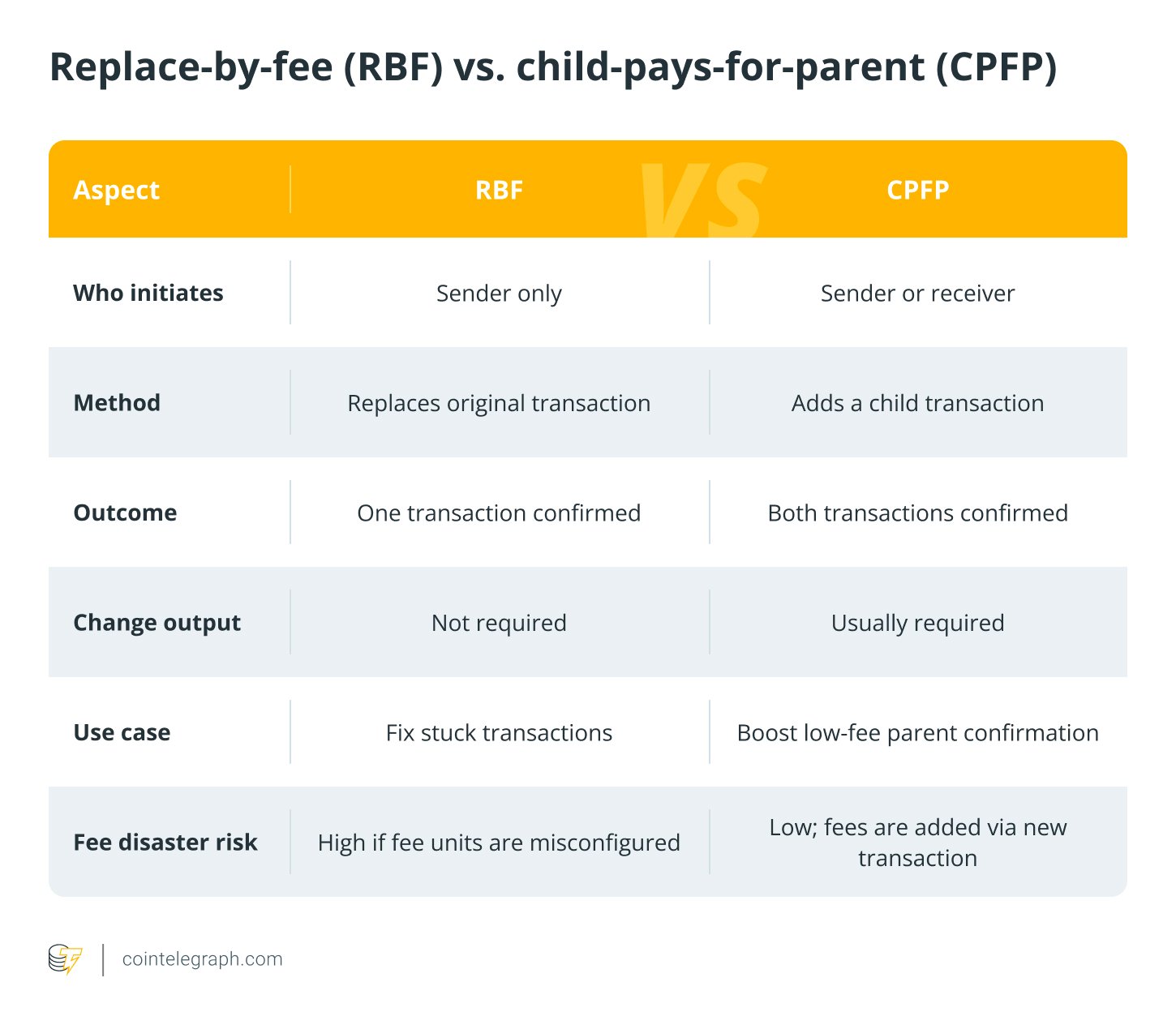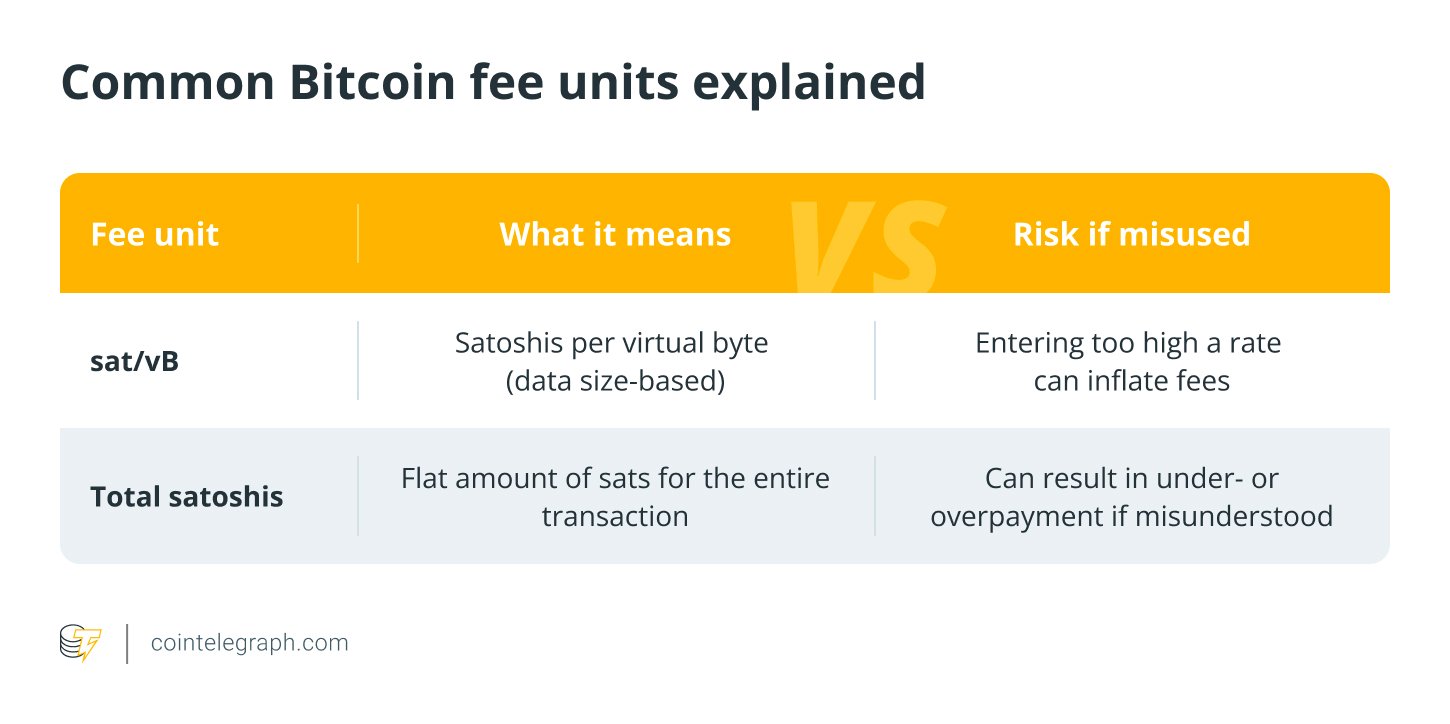Key takeaways
-
A misunderstanding of fee units led to an accidental overpayment worth more than $60,000 during a replace-by-fee transaction.
-
The user confused sat/vB (fee per byte) with total satoshis, leading to an extreme overpayment.
-
RBF replaces a transaction with a higher-fee version, while CPFP adds a new transaction to boost the original; each has different use cases and risks.
-
Use trusted wallets, double-check fee units, and let the wallet suggest optimal fees. Avoid panic, stay updated and always verify transactions before hitting “send.”
Around 00:30 UTC on April 8, 2025, a Bitcoin user attempted to expedite a pending transaction using replace‑by‑fee (RBF). But instead of a modest bump, their wallet mistakenly spent 0.75 Bitcoin (BTC), roughly $60,000–$70,000, purely on fees.
How does something like this happen? And more importantly, how can you ensure it doesn’t happen to you?
Let’s break it down.
Why did a Bitcoin user end up paying $60,000 in fees?
The user wanted to send 0.48 BTC (around $37,770 at that time) using Bitcoin’s RBF feature. This feature lets you resend a transaction with a higher fee if the original one is stuck in the mempool (the waiting area for unconfirmed transactions). In this case, things went wrong, very wrong.
The Timeline:
-
First transaction: Sent with a standard fee, not high enough to confirm quickly.
-
First RBF attempt: Doubled the fee and changed the recipient (output) address.
-
Second RBF attempt: Added a large unspent transaction output (UTXO), about 0.75 BTC, but forgot to redirect the change back to their own address.
The result? That 0.75 BTC was treated as a fee and sent to miners.
Anmol Jain, vice president of investigations at crypto forensics firm AMLBot, told Cointelegraph that the user likely started with a “default or conservative” transaction fee, which is nothing unusual. Then came the mistake: confusing how the fee was being measured.
Many Bitcoin wallets allow you to set fees in one of two ways:
-
Total fee in satoshis (the smallest Bitcoin unit, like cents to a dollar)
-
Fee per virtual byte (sat/vB), which measures how “heavy” the transaction is in data terms
Here’s where things went wrong, according to Jain:
“System reads it as 30 sats total fee, which is way too low, so user types 305000 thinking it means 30.5 sat/vB, and the wallet actually applies 305,000 sats/vB, which is insane.”
In simple terms, the user may have seen a warning that their fee, just 30 sats total, was too low for the transaction to be processed quickly. So, trying to fix it, they might have typed in 305,000, thinking it meant “30.5 sats per byte.”
But instead of adjusting the fee moderately, the wallet took that as 305,000 sats per byte, a monstrous fee that blew past any norm and resulted in a loss of more than $60,000.
Why it matters
This highlights how minor confusion between fee units can lead to major losses, especially when manually entering numbers quickly or using advanced wallet settings without fully understanding them.
So if you ever adjust Bitcoin fees, double-check the unit you’re setting. Whether it’s “total sats” or “sats per byte” makes a world of difference, as this costly mistake proves.
Did you know? In September 2023, a user paid a $500,000 fee for a single BTC transaction. It turned out to be an error by Paxos, a crypto infrastructure company.
Replace-by-fee (RBF): What Is It?
Bitcoin transactions aren’t final until they’re added to a block. If a transaction is stuck, you can use RBF to resend it with a higher fee to encourage miners to pick it up faster.
It was originally proposed by Bitcoin’s creator, Satoshi Nakamoto, and later formalized as “opt-in RBF” by developer Peter Todd, according to the BitGo Developer Portal.
How it works:
-
You enable RBF when sending the original transaction.
-
If the transaction remains unconfirmed, you can create a replacement with a higher fee.
-
Miners will likely choose the higher-fee version because they’re financially incentivized to do so.
But here’s the catch: if you mess up the inputs or outputs, especially the change address, it can cost you dearly.
Notably, RBF differs from child-pays-for-parent (CPFP) in that RBF replaces the original unconfirmed transaction with a higher-fee version, and only the sender can initiate it. In contrast, CPFP adds a high-fee child transaction to boost the parent’s confirmation, and can be initiated by either the sender or the receiver.

Why did the Bitcoin transaction fee spike so high?
There are a few theories behind what caused the absurd fee in this case:
-
Confusion over fee units: The fee spiked likely due to a misunderstanding of fee units. Instead of setting a reasonable rate per byte, the user may have accidentally entered a large absolute value, causing the wallet to apply an excessively high fee.

-
Automation gone wrong: If the wallet uses automated scripts or has bugs in how it processes RBF, a user’s input can be misread or, worse, executed without proper warnings.
Why RBF is controversial
The RBF feature has sparked years of debate within the crypto community. While it’s useful for fixing stuck transactions, critics like Mike Hearn (former Bitcoin developer) argued on Medium that it:
-
Enables double-spending attacks, especially for in-person merchant transactions.
-
Encourages miner-fraudster collusion.
-
Adds complexity, making user errors more likely.
-
Undermines finality, as unconfirmed transactions can be replaced.
To address this issue, Bitcoin Cash (BCH), for example, removed RBF support and says that unconfirmed transactions are final. However, due to how mempools work, similar RBF-like replacements can still happen, even on BCH.
Did you know? In November 2023, a 139 BTC transaction (worth millions) included a $3.1 million fee.
How to protect yourself from high Bitcoin transaction fees
You don’t need to fear RBF, but you do need to respect it. Here are some tips to avoid becoming the next viral fee fail:
-
Choose a secure Bitcoin wallet with transparent fee options: Choose reputable Bitcoin wallets that clearly display and explain fee types.
-
Understand Bitcoin fee units before sending: Learn the difference between sat/vB (satoshis per virtual byte) and total satoshis to avoid accidental overpayments.
-
Always double-check your transaction before confirming: Verify the recipient address, fee amount and the change address to ensure no funds are mistakenly used as miner fees.
-
Let the wallet suggest the fee, especially if you’re new: Most wallets offer dynamic fee recommendations based on network congestion, so use them instead of manually entering values.
-
Test with a small Bitcoin transaction first: Send a low-value test transaction to confirm everything is set correctly before sending a significant amount.
-
Monitor Bitcoin network fees in real time: Use websites like mempool.space to check current fee rates and choose the best time to send your transaction.
-
Avoid panicking over slow confirmations: Bitcoin transactions can take time. Wait before resending or replacing transactions unless you’re sure it’s necessary.
-
Stay informed about wallet updates and bugs: Follow your wallet provider for updates, as software bugs or interface changes can impact how fees are calculated or displayed.
If you skip the above precautions, you could pay hundreds or even thousands of dollars in unnecessary fees, with no way to recover the loss. When it comes to Bitcoin, one small mistake can become a costly lesson.
This article does not contain investment advice or recommendations. Every investment and trading move involves risk, and readers should conduct their own research when making a decision.
Read the full article here










